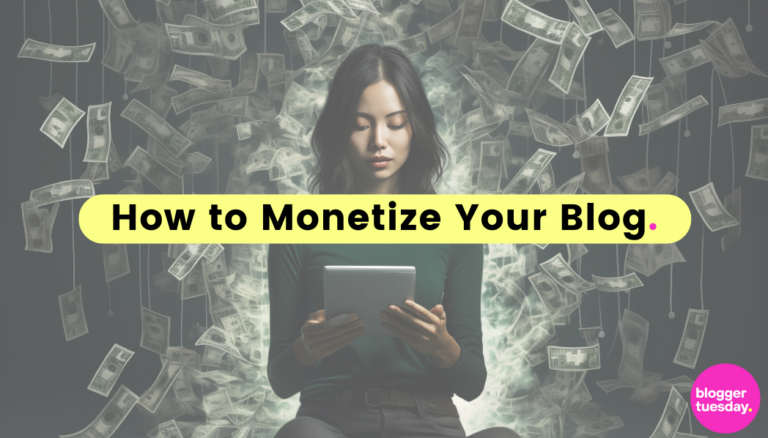So, you’ve created your blogging site and have developed your skills to produce high-quality content that your readers love. That’s great. But if you want to turn blogging into a career (or even a well-paid side hustle) knowing how to monetise a blog is essential.
This quick guide will help you discover the best way to monetise a blog in 2025 and beyond.
Assess Your Blog’s Monetisation Potential
Before researching “How to monetise my blog”, it’s important to paint a clear picture of where your platform currently stands and what a realistic level of revenue might look like. Firstly, it is suggested that only 5% of bloggers make a full-time income from their online activities, which highlights that it is difficult yet possible.
Your blog’s monetisation potential will be influenced by a variety of contributing factors, including but not limited to;
- The niche of your blog,
- How many readers you attract,
- How engaged your readers are with the content,
- The spending power of your readers,
- The level of competition in your niche,
- Which monetisation avenues may be open,
- The type of content you publish,
- How frequently you post content.
In addition to monetising the blog, your skills could open the door to paid blogging opportunities elsewhere. As for learning how to monetise a blog of your own, there is no set formula to calculate how much you might earn. However, most agree that at least 10,000 unique pageviews per month will be needed before you can generate a good level of revenue.
Choose the Right Monetisation Model for Your Blog
When searching “How to monetise my blog in 2025”, the first thing you will notice is that there are several revenue streams to consider. The best monetisation model is likely to include a multi-faceted approach, which is why it’s vital to understand them all.
The best way to monetise a blog is to develop a defined and comprehensive strategy. The following items should be on the agenda:
Explore Affiliate Marketing Opportunities
Affiliate marketing is one of the most commonly used revenue tools by bloggers and influencers alike. You promote a product or service to your readers on behalf of a brand and then earn a commission whenever someone purchases them through your personalised link.
An estimated 15% of all revenue generated from digital media comes courtesy of affiliate marketing. It is a popular resource for bloggers as there are no expenses involved and they can also promote as many products as they like across a variety of channels including social media and email newsletters as well as their main blog posts. Make the most of it by;
- Finding affiliate schemes where companies pay a higher commission.
- Focus on a combination of high-value products and high-volume goods.
- Be transparent that buying through your link will earn you some money.
Implementing Display Advertising Effectively
Display advertising is often the first revenue stream implemented by bloggers because it is the most accessible for beginners. You simply place some HTML code on your website and a PPC ad will show on your website. If a user clicks the ad, you make money.
There is no fixed level of earnings through this method, but Google AdSense (the most popular display ad network) pays an estimated £0.16 – £2.03 per 1,000 page views. It’s not a huge level of income unless you have a huge readership but does bring some money in with very little effort. You can ensure that your display advertising efforts deliver more money by;
- Choosing the right display ad network. Some others may pay more than AdSense.
- Selecting the right ad placements. Top of page and bottom of article ads work well.
- Confirming that the ads display correctly on both desktop and mobile browsers.
Incorporate Sponsored Posts and Collaborations
Brand collaborations are a fantastic way to take your blog earnings to the next level as it allows you to secure a significant fee from the company sponsoring your blog posts. It should be noted, though, that you’ll need high traffic and significant credibility to make it worthwhile for them.
Sponsored posts work best when the sponsor backs an entire series of posts, such as a weekly feature. Companies may also partner with bloggers to promote their products. You charge the client to have their name, logo, and website link prominently shown on the blog post. Collaborations may also manifest via;
- Sponsored podcasts, video content, or social media posts.
- Brand takeovers on their social media channels or via guest blogging.
- Collaborative content where you work directly with the company.
Offer Exclusive Content through Memberships
You pride yourself on creating high-quality content, and your readers certainly enjoy the value that you provide. However, that doesn’t mean you have to publish everything for free. Exclusive content that sits behind a paywall or a membership can create a strong revenue stream.
An estimated 21% of Brits (plus millions of people worldwide) now embrace online courses. Likewise, readership of eBooks and listenership of podcasts have grown exponentially in recent years. Whether they are loyal fans who can’t get enough of your content or want to learn from your experience and knowledge within your niche, exclusive content will appeal. It can cover;
- Patreon accounts or other outlets for exclusive ‘members-only’ content.
- Content like videos or podcasts without ads. Or content that is released earlier to them.
- Access to courses, online training, and other services related to your blog.
Utilise Email Marketing for Direct Monetisation
If you have ever researched the most effective marketing strategies for businesses, email marketing is one of the best performers in terms of ROIs. It can be very effective for bloggers as readers are already aware of your brand and have signed up to receive your correspondence.
Many entrepreneurs have launched successful businesses off the back of their blogs. High open rates ensure that email marketing can play a key role in generating conversions, not least because email campaigns can be automated once a user has triggered them. They can;
- Direct readers to products or merchandise that you have launched.
- Promote your paid content or direct them to your affiliate marketing products.
- Invite readers to book a course or a consultation with you.
Optimise and Scale Your Monetisation Strategies
When looking at the best ways to monetise a blog, selecting the right strategies is a great starting point. Whichever methods you use, though, it’s imperative that you optimise them simultaneously keeping one eye on the future with scalable solutions.
Here are some of the best ways to achieve the best returns while also growing;
- When connecting with brands, choose businesses that align with your brands.
- Look for affiliate marketing platforms that offer higher commissions.
- Know your worth, whether charging for sponsored posts or premium content.
- Hire some extra bloggers to increase your output and earnings.
- Collaborate with other content creators where possible.
- Don’t be afraid to launch your own merchandise through ideas like print-on-demand.
- Increase your fees as your blog grows, detailing the reasons why to your clients.
Take the Next Steps to Boost Your Blog’s Revenue
By now, you should feel able to build a clear strategy that allows you to start earning money from your platform and upscale over time. So, what next? Get writing your next blog post. Quality content is at the heart of everything.


